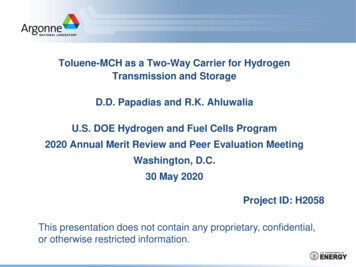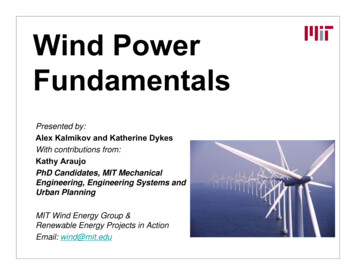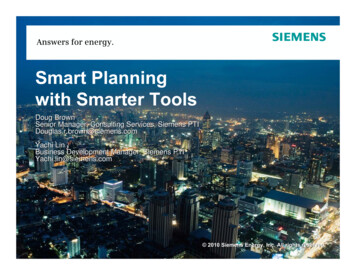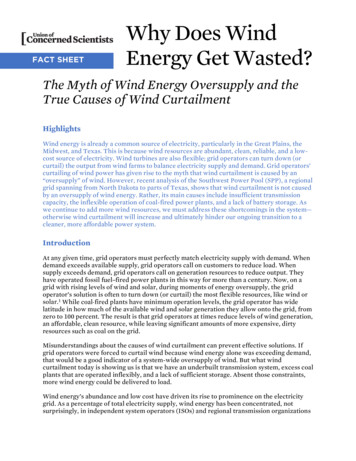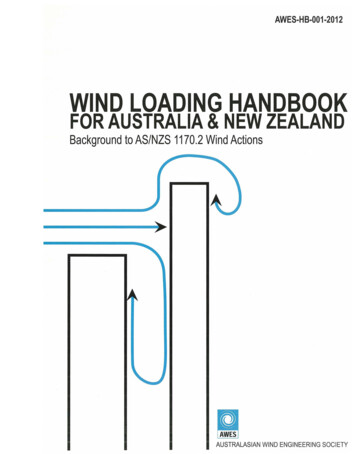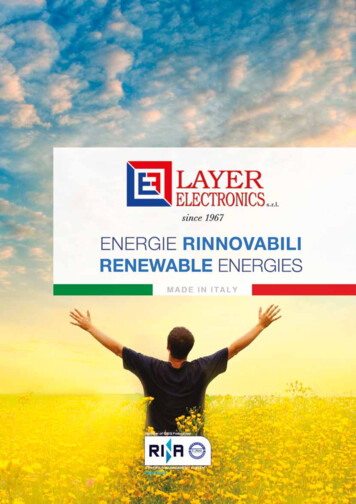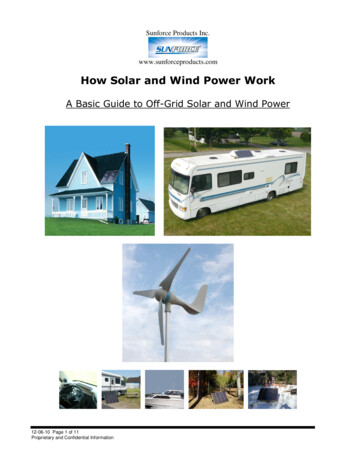
Transcription
Sunforce Products Inc.www.sunforceproducts.comHow Solar and Wind Power WorkA Basic Guide to Off-Grid Solar and Wind Power12-06-10 Page 1 of 11Proprietary and Confidential Information
Sunforce Products Inc.www.sunforceproducts.comImportant Solar and Wind Information:How Solar Works Under 15 WattsHow Solar Works Over 15 Watts12-06-10 Page 2 of 11Proprietary and Confidential Information
Sunforce Products Inc.www.sunforceproducts.comHow Wind WorksSunforce 600 Watt Wind TurbineSunforce 400 Watt Wind Turbine12-06-10 Page 3 of 11Proprietary and Confidential Information
Sunforce Products Inc.www.sunforceproducts.comOff Grid solar systems charge a battery or a battery bank!Battery Recommendations:The solar panels charge rechargeable 12 Volt batteries. Deep cycle batteries are best,as opposed to starting (automotive) batteries. Additional batteries may be placed in the system to increase the storage space forenergy produced; enabling the user to power more appliances for longer.What STORAGE CAPACITY do I need?This depends on the max load required. Load can be determined using the consumption ofyour appliances and/or electronics, and multiplying them by the hours of usage per dayrequired. To be safe – it is always good to double your load when calculating the size ofyour solar system.Is your solar array large enough to provide this load?*100 Amp Hour Reserve is a safe bet if you have no other informationThe standard battery used for storing off-grid electricity is a lead-acid, AGM type, or deepcycle marine battery. We recommend the use of deep cycle (marine or RV) batteries asthey will give you several hundred complete charge/discharge cycles. If you use thenormal vehicle starting batteries they will wear out after about a dozen charge/dischargecycles.For proper charging of the batteries multiple batteries should be wired as shown. This will ensurethat the batteries are charged as equally as possible.12 Volt Battery Bank:12-06-10 Page 4 of 11Proprietary and Confidential Information6 Volt Battery Bank:
Sunforce Products Inc.www.sunforceproducts.comInvertersWhat is the difference between a Pure Sine Wave inverter and a Modified SineWave inverter?A pure sine wave inverter most closely matches regular AC power that comes from yourelectric company. This clean power has very low harmonic distortion which allows for aclearer picture on your screen and less static or noise. Motors run faster, more quietly,and produce less heat.A modified sine wave inverter’s voltage fluctuates and may cause difficulties whenrunning sensitive electronic equipment. The power wave is not exactly the same aselectricity from the power grid and this may cause damage to electronic equipment.12-06-10 Page 5 of 11Proprietary and Confidential Information
Sunforce Products Inc.www.sunforceproducts.comWant to learn more?Solar Technology:PHOTOVOLTAICS - How it worksPhotovoltaic (PV) systems produce electricity when exposed to sunlight. Sunlight iscomposed of particles of energy called photons. When sunlight strikes a PV material,photons will either pass through, be reflected, or be absorbed. If the photon is absorbed,its energy will be transferred to an electron in an atom of the PV material. With its newfound energy, the electron is able to escape from its normal position in orbit around thatatom. In this way, the electron can become part of, and augment, the current in anelectrical circuit. This "photovoltaic effect" is the basic physical process through whichsunlight is converted into electricity. The primary building block of a PV system is the PVcell. A typical PV cell is about 3 X 3-in. and very thin. By itself, a single PV cell producesonly a small amount of electricity. Fortunately, we can easily increase the total power in aPV system by connecting several cells to form larger units called modules. Modules, inturn, can be connected to form even larger units know as arrays, which can beinterconnected to produce more power, and so on. In this way, we can build a PV systemto meet almost any power need, no matter how small or great.Types of Solar Cells:All commercially viable PV products are made using one of two groups of technologies;Crystalline Silicon or Thin Film materials.CRYSTALLINE SILICONTraditional crystalline silicon is by far the most common solar cell material for commercialapplications because: It has been in use for more than 50 years, and its manufacturing processes are wellknown. Those processes are now largely in the public domain.12-06-10 Page 6 of 11Proprietary and Confidential Information
Sunforce Products Inc.www.sunforceproducts.com The raw material used, silicon, is very abundant (it's the second most abundantelement in the Earth's crust - second only to oxygen)Forms of Crystalline Silicon PVThere are two basic forms of crystalline silicon PV; Single-crystalline silicon andPoly-crystalline silicon.Crystalline Silicon Points: Higher efficiency Durable – Ideal for permanent installations Little maintenance required Designed to withstand rigorous weather conditionsTHIN-FILMThin-Film FormsThe principal thin-film technologies is Amorphous Silicon (a-Si)Amorphous Silicon Points: Lightweight, portable, shade tolerant For entry to solar or hands on solar Generally used for the chassis battery Best for smaller output temporary set ups, areas that do not receive predictablesun conditions12-06-10 Page 7 of 11Proprietary and Confidential Information
Sunforce Products Inc.www.sunforceproducts.comVisit our Solar and Wind Calculators!Solar Calculator: http://www.sunforceproducts.com/solar calculator.phpWind Calculator: http://www.sunforceproducts.com/english/wind support.asp12-06-10 Page 8 of 11Proprietary and Confidential Information
Sunforce Products Inc.www.sunforceproducts.comOff- Grid Solar Check ListDID YOU FORGET? .1) A battery for your solar system A 12V deep cycle (Marine or RV) battery is recommended (see page 4)2) A charge controller for battery overcharge and discharge protection3) An inverter to use AC power with your solar system (see page 5) The size you choose depends on the Watts (or Amps) of what you wish torun with your system. It is recommended to buy an inverter at least 10 to20% more than your largest start up load.4) Proper wiring for your system Correct wiring is very important when installing a larger solar system. Thewiring included in the retail box of your panel may only be sufficient forwiring one panel at a time (see your Sunforce user manual). Please consultan electrician or one of the following two tables for detailed information;http://www.windsun.com/Hardware/Wire .12-06-10 Page 9 of 11Proprietary and Confidential Information
Sunforce Products Inc.www.sunforceproducts.comOFF GRID VS. GRID TIED SYSTEMSOff Grid: Wind generators and solar panels are often used to power a structure that is notattached to regular electric supply; these are Off Grid applications.Examples include:-hunting cabins-barns or stables on farms not attached to the regular electric-houses beyond the power lines-detached garages-remote and back up powerThese wind generators or solar panels charge up batteries which are then used to poweryour appliances with the use of an inverter. Inverters enable you to use everyday items,just like at home, but using power you’ve generated with your wind generator or solarpanels.The inverter allows you to use the sun and/or wind as your power source with minimalchange to your daily routineGrid-Tied*: One may also use a wind or solar powered system to contribute to theirhousehold power that is normally provided by the electric system. This is called a GridTied system. In a grid tied system, a wind generator or solar panel(s) attach directly toyour home through your power meter. Your home remains attached to the regular powerlines and power produced from the wind generator is logged by the meter. Just like themeter logs how much energy is used, it will keep track of how much energy is contributedby the wind generator; your electric bill will reflect this. With enough sun or wind youcould bring your electric bill down to zero!*Please note Sunforce does not currently carry grid-tied inverters, and mostSunforce panels are not designed for grid-tied use. Please contact us for furtherinformation when inquiring about connecting to the grid.12-06-10 Page 10 of 11Proprietary and Confidential Information
Sunforce Products Inc.www.sunforceproducts.comHow to Contact Us?Sunforce Customer Service Product InformationPhone: 1-888-478-6435Email: Info@sunforceproducts.comMore information and Online SupportWWW.SUNFORCEPRODUCTS.COM12-06-10 Page 11 of 11Proprietary and Confidential Information
Photovoltaic (PV) systems produce electricity when exposed to sunlight. Sunlight is composed of particles of energy called photons. When sunlight strikes a PV material, photons will either pass through, be reflected, or be absorbed. If the photon is absorbed, its energy will be transferred t


